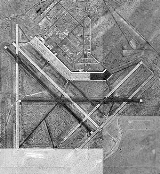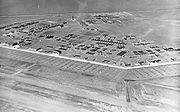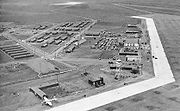
Marfa Army Airfield
Encyclopedia


Texas
Texas is the second largest U.S. state by both area and population, and the largest state by area in the contiguous United States.The name, based on the Caddo word "Tejas" meaning "friends" or "allies", was applied by the Spanish to the Caddo themselves and to the region of their settlement in...
, about 200 miles (321.9 km) southeast of El Paso
El Paso, Texas
El Paso, is a city in and the county seat of El Paso County, Texas, United States, and lies in far West Texas. In the 2010 census, the city had a population of 649,121. It is the sixth largest city in Texas and the 19th largest city in the United States...
.
History
During World War IIWorld War II
World War II, or the Second World War , was a global conflict lasting from 1939 to 1945, involving most of the world's nations—including all of the great powers—eventually forming two opposing military alliances: the Allies and the Axis...
, Marfa Army Airfield, was an installation of the Army Air Force Training Command West Coast Training Center.
Origins
Marfa’ s affair with the United States military actually began long before Marfa Army Airfield (AAF). In 1911, the United States Army stationed cavalry units at what they eventually named Camp Marfa in order to patrol the Rio GrandeRio Grande
The Rio Grande is a river that flows from southwestern Colorado in the United States to the Gulf of Mexico. Along the way it forms part of the Mexico – United States border. Its length varies as its course changes...
because of the turbulent Mexican Revolution. The camp remained on a permanent basis and was renamed Fort D. A. Russell in 1930 but closed, presumably permanently, in 1933. Only two years later, however, the fort reopened as an army officer training school. Fort D. A. Russell remained active until 23 October 1945.
Planning for the construction of Marfa AAF began in March 1942, when the War Department selected the Marfa, Texas
Marfa, Texas
Marfa is a town in the high desert of far West Texas in the Southwestern United States. Located between the Davis Mountains and Big Bend National Park, it is also the county seat of Presidio County. The population was 1,981 at the 2010 census....
area as a site for training United States Army Air Corps
United States Army Air Corps
The United States Army Air Corps was a forerunner of the United States Air Force. Renamed from the Air Service on 2 July 1926, it was part of the United States Army and the predecessor of the United States Army Air Forces , established in 1941...
advanced twin-engine pilots. The Southern Pacific Railroad
Southern Pacific Railroad
The Southern Pacific Transportation Company , earlier Southern Pacific Railroad and Southern Pacific Company, and usually simply called the Southern Pacific or Espee, was an American railroad....
tracks ran parallel to Route 90 at this area, and the highway & railroad provided excellent logistics support for the new airfield. McGough Brothers of Houston was the general contractor for the facility. Marfa and nearby Alpine each voted $10,000 in bonds to buy the land for the airfield, 2750 acres (11.1 km²), from T. G. Hendrick of Abilene
Abilene, Texas
Abilene is a city in Taylor and Jones counties in west central Texas. The population was 117,063 at the 2010 census. It is the principal city of the Abilene Metropolitan Statistical Area, which had a 2006 estimated population of 158,063. It is the county seat of Taylor County...
at $6.50 an acre. The towns, in turn, leased the property to the War Department for twenty-five years at one dollar a year. A federal court directed C. T. Mitchell, Mrs. Bertha Holmes, the John A. Lawrence estate, and the Gage estate to deliver 1809 acres (7.3 km²) for four auxiliary landing fields.
Construction began in June 1942, and enough construction was finished for the first cadets to arrive on 5 December 1942. As built during the war, the airfield at Marfa consisted of a total of 6 asphalt runways (up to 7,500' long),with an extensive network of taxiways & ramps. Adjacent to the airfield to the north was an extensive street grid, with a large number of buildings (eventually totaling nearly 250 buildings), including a hospital, barracks, chapel, theater, mess halls, control tower, and hangars.
Auxiliary airfields
Auxiliary landing fields for the use of Marfa AAF eventually included:- Marfa AAF Aux #1. 30°08′58.10"N 103°50′28.52"W
- Located 15 miles SSE of Marfa AAF, apparently reused for at least some period of time as an airport known as "South Airport", closed in the 1950s. Now abandoned.
- Marfa AAF Aux #2. 30°21′25.68"N 104°12′46.71"W
- Located 10.5 miles WNW of Marfa AAF, closed during World War II. Abandoned ever since.
- Marfa AAF Aux #3. 30°24′55.46"N 104°17′50.96"W
- Located 16.5 miles WNW of Marfa AAF, apparently reused for at least some period of time as a airport known as "Ryan Airport", closed in the 1950s. Now abandoned.
- Marfa AAF Aux #4. 30°22′10.77"N 104°00′53.88"W
- Located 4 miles NW of Marfa AAF, developed into Marfa Municipal Airport
- Marfa AAF Aux #5. 30°21′31.15"N 104°10′16.75"W
- Located 8.5 miles WNW of Marfa, apparently reused for at least some period of time as a airport known as "Aragon Airport", closed in the 1950s. Now abandoned.
- Marfa AAF Aux #7. 30°19′40.47"N 103°59′32.26"W
- Located 2 miles NW of Marfa AAF. Originally built by the United States Army in 1919 for purpose of patrolling the Mexican border by airplane. This installation was attached to Camp Russell when it was made a permanent military establishment in 1927. The Army's air patrols of he area were discontinued in 1923, and the airfield was turned over to the town of Marfa which made it their Municipal Airport. The Marfa Municipal Airport continued to be used by the military on an as-needed basis until World War II. With the construction of large Marfa Army Airfield, It was taken over by the AAF and became Marfa Auxiliary Airfield #7. After the war, it was never reused as a civil airfield, and it was abandoned. It has since been redeveloped into a golf course.
Operations
The base at first was designated Marfa Army Air Field, Advanced Flying School and was assigned to the Army Air Forces Flying Training Command. In June 1943, the name was changed to Marfa Army Air Field, Army Air Forces Advanced Flying School.On 25 November 1942 the first shipment of Cessna AT-17
Cessna AT-17
-References:NotesBibliography* Mondey, David. American Aircraft of World War II . London: Bounty Books, 2006. ISBN 978-0-7537-1461-4....
B twin-engine trainers arrived from Cessna in Wichita, Kansas
Wichita, Kansas
Wichita is the largest city in the U.S. state of Kansas.As of the 2010 census, the city population was 382,368. Located in south-central Kansas on the Arkansas River, Wichita is the county seat of Sedgwick County and the principal city of the Wichita metropolitan area...
. A flow of aircraft continued to be delivered as training ramped up. The first class started training on 11 December 1942, several weeks ahead of planned schedule. Members of this class (43-B) completed their courses by 6 February 1943, and received their silver wings. A class completed training each month until the final graduation in May 1945. By 30 April 1944, the base had a total complement of 3,293 personnel: 575 officers, 2,114 enlisted men, and 604 civilians. At its peak, Marfa AAF would operate a staggering total of 500 aircraft.
Newspaper articles from this period reflect a vast number of social interactions between the personnel of Marfa AAF and their families and people within the local community. The base had a basketball team that competed with local high school teams, and some of the games were even held at the base gymnasium. Young men considering service in the Army Air Corps were invited to tour the base, and the base’s public relations officer wrote a series of editorials in favor of the Army Air Corps in the Big Bend Sentinel.
As one might expect, the men of Marfa AAF also married local girls, and the local paper’s society pages were constantly announcing such marriages. Local churches often featured base officers as guest speakers, presentations from the wives of base personnel, and even choir soloists from amongst the men of Marfa AAF. The sons of Marfa personnel competed in regional Boy Scouts competitions. Parades were held at the base for Army Day and Victory in Europe Day
Victory in Europe Day
Victory in Europe Day commemorates 8 May 1945 , the date when the World War II Allies formally accepted the unconditional surrender of the armed forces of Nazi Germany and the end of Adolf Hitler's Third Reich. The formal surrender of the occupying German forces in the Channel Islands was not...
, an open house was held for the local residents to come tour the base, and the base color guard performed in the county rodeo. The base even held a beauty contest one year for local girls, with the winner representing Marfa AAF at the El Paso Sun Bowl. On a more serious note, the base personnel helped serve the community. On one occasion, a Marfa airman saved two women from drowning in nearby Alpine. On another occasion, the base personnel contributed to Marfa s donation to the Red Cross War Fund Drive, with 430 civilian workers and more than 1,500 airmen giving at least $1 each and making up about half of the town’s entire contribution.
The community of Marfa and Presidio County in turn gave back to the base on a social level. Marfa residents donated recreation equipment and furniture to the base for use in their clubs and recreation areas. They also gave the young airmen without cars rides to local sporting events. For those airmen who were far from home, local residents invited them to Christmas dinners, and local women played substitute mothers for Mother’s Day. The Rotary clubs of Marfa and Alpine paid for the construction of an adobe block entrance to Marfa AAF, and the community held a big celebration in honor of the base’s two-year anniversary.
In June 1944 Air Training command transferred Marfa Army Air Field to Second Air Force
Second Air Force
The Second Air Force is a numbered air force of the United States Air Force Air Education and Training Command . It is headquartered at Keesler Air Force Base, Mississippi....
. Training continued and classes included regular trainees, Chinese nationals, and Air Transport Command
Air Transport Command
Air Transport Command is an inactive United States Air Force unit. Its mission was to meet the urgent demand for the speedy reinforcement of the United States' military bases worldwide during World War II, using an air supply system to supplement surface transport...
personnel. On-the-line pre-pilot training and mechanics courses were added, and some A T-6 Texan
T-6 Texan
The North American Aviation T-6 Texan was a single-engine advanced trainer aircraft used to train pilots of the United States Army Air Forces, United States Navy, Royal Air Force and other air forces of the British Commonwealth during World War II and into the 1950s...
advanced single engine trainers were also used at Marfa AAF. The B-25 Mitchell
B-25 Mitchell
The North American B-25 Mitchell was an American twin-engined medium bomber manufactured by North American Aviation. It was used by many Allied air forces, in every theater of World War II, as well as many other air forces after the war ended, and saw service across four decades.The B-25 was named...
bomber was also used for multi-engine training at Marfa during the later portions of the war to retrain pilot returnees.
On 4 May 1945, the local newspaper announced that the May graduating class would be the last. In June Marfa Army Air Field became a redeployment center for the I Troop Carrier Command
I Troop Carrier Command
The I Troop Carrier Command is an inactive United States Air Force unit. Its last assignment was with the First Air Force, based at Stout Army Air Field, Indiana.Its primary mission was theater troop and logistics transport training...
, with some 2,400 men to be sent there to train with C-46 and C-47 aircraft. The host unit at the airfield was renamed the 818th Air Base Unit. The end of World War II halted these plans. More than 500 veterans from various squadrons arrived at the base for redeployment or discharge.
Closure
Marfa AAF was placed on standby status from 25 May to 15 June 1945. Much of the equipment & aircraft were reassigned. A few administrative aircraft remained & base operations became inactive. The field remained open for transient aircraft on official business or for emergency landings. By V-J day on 14 August 1945, the field was no longer required for a redeployment center for the TCC, although the 437th Troop Carrier Group was assigned to Marfa from 14 September to 15 November. By the end of 1945, flying operations at Marfa rapidly wound down, with the base having only one C-64, twenty C-47s and one B-25 by 30 November. The base manpower was reduced to a total of 1,133.From December 1945 to 31 January 1946, the base was listed as "inactive". During this time, many of the assets were advertised for sale as surplus property. This included such things as a bowling alley, office equipment, trucks, shelving, etc. All operations at Marfa AAF were suspended by February 1946. The base was retained by the 818th AAF BU and later the 344th AAF BU, and the military finally declared the base surplus on 22 October 1946. When the base finally closed, the townspeople held a number of going-away parties, dances, and barbecue
Barbecue
Barbecue or barbeque , used chiefly in the United States, Canada, the United Kingdom, New Zealand and Australia is a method and apparatus for cooking meat, poultry and occasionally fish with the heat and hot smoke of a fire, smoking wood, or hot coals of...
s for the departing airmen and their families.
Postwar use
On January 31, 1947, the base was transferred by the Ninth Air Force to the Army District Engineering Corps at Albuquerque, NM for disposition. The closure of Marfa AAF was an emotional blow for the community of Marfa and Presidio County. As reflected in the local newspaper, the local community suffered an emotional depression and in the words of the mayor, the town "fell on its face." Sinking spirits and a sense of loss would not be the only blow dealt to the community by the base closure. The impact on the community of Marfa and Presidio County in terms of population and economic prosperity was obviously a devastating one, however the community was able to eventually recover to some degree within 5 years of the airfield's closure.Marfa was used as a civil general aviation airport after the war known as "Marfa Alpine Airport" until the 1960s. In the early 1960s, the area became popular for long-distance soaring flights. The national championships were held there in the late 1960s. In September 1966 President Lyndon Johnson's wife Lady Bird Johnson
Lady Bird Johnson
Claudia Alta "Lady Bird" Taylor Johnson was First Lady of the United States from 1963 to 1969 during the presidency of her husband Lyndon B. Johnson. Throughout her life, she was an advocate for beautification of the nation's cities and highways and conservation of natural resources and made that...
, flew into the airport to dedicate Fort Davis as a National Historic Site
National Historic Sites (United States)
National Historic Sites are protected areas of national historic significance in the United States. A National Historic Site usually contains a single historical feature directly associated with its subject...
. It was listed as "Presidio County Airport" in the 1970 TX Airport Directory, however the airport was evidently closed at some point between 1970-1985 as the runways were labeled as “Abandoned” on the 1985 USGS topo map.
Today, all of the runways, taxiways & ramps of this huge airfield still exist. Although many of the wartime buildings were sold at action and moved to Marfa or nearby Alpine, Texas, large numbers of wartime buildings still stand on the base with several hangars in existence. One of the hangars has been turned into an art gallery as part of the Chinati Foundation. The old officer's club has been turned into a B&B. In the basement, there is a mural that was drawn by World War II German POWs. Slowly, however, the West Texas desert is reclaiming the large airbase, with tall grass being found on the parking apron, and deteriorating concrete evident on the taxiways and runways.
The original main entrance road still exists, however it is gated and locked. A small brass memorial plaque can be found on the remains of the World War II adobe block entrance to the post.
See also
- Texas World War II Army AirfieldsTexas World War II Army AirfieldsIn today's United States Air Force, many personnel have spent some of their military service being trained in Texas during World War II. Be it basic military training at Lackland Air Force Base, technical training, officer training, or flight training at other facilities across the state...

